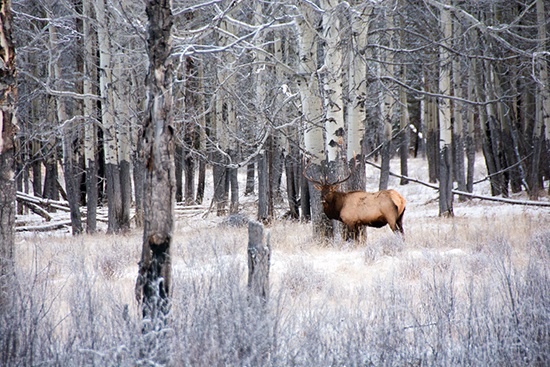Yellowstone Winter Wildlife in Photos

With sparse crowds and breathtaking snow-coated scenery, winter is a great time for photographers and adventurous travelers to visit Yellowstone and its signature feature, Old Faithful. Scenic Safaris offers several options for vacationers looking to trek Yellowstone during the snowy season. Hop on a snowmobile for a 12-hour guided tour focused on the geyser or take a leisurely (and heated!) ride by snow coach. Scenic Safaris also offers multi-day trips for those who want to take their time at Yellowstone and really see the sights. No matter which option you choose, here are some of the majestic creatures you’re likely to encounter on the journey.

Bison
According to the National Park Service, bison have lived at Yellowstone since prehistoric times. The park’s bison population tops out at about 5,500 animals. Though a few of the park’s bison won’t survive the winter, they are generally built to withstand harsh temperatures. Their long, shaggy fur provides insulation, while their “hump” contains muscles that make the bison a living snowplow! Look for migrating bison in low areas of the park and near the west and north boundaries.

Wolves
Though Yellowstone has a hearty wolf population – about 100 animals – they’re a rare sight. Luckily, winter is the best time to view wolves inside the park. The thick snow makes it easier to spot wolf footprints and see their grey coats against the white background. The best place to look for winter wolves is in the Lamar Valley on the east side of the park. If you do come across a wolf pack or lone scout, keep a safe distance and listen to any instructions from your Scenic Safaris guide.

Sheep & Rams
Yellowstone’s Bighorn sheep herds remain nonplussed by winter storms. Mating season begins in November, causing herds to become extra active. Watch for displays of dominance in which rams of similar sizes interlock horns and compete for desirable females. Bighorn sheep aren’t accessible during Scenic Safaris’ day-trips to Yellowstone; however, they can often be spotted during a guided outing in the nearby Gros Ventre Mountains.

Elk
In recent years, elk have been migrating out of the park in winter. Why? They eat grasses, leaves and other plant materials, which can be understandably difficult to find in a snowy landscape. The good news is that winter is the best time to photograph the herds that remain. Elk antlers are at full growth in winter and remain intact until they’re shed in March or April.

Foxes and Other Woodland Critters
Yellowstone is home to 67 types of mammals, from deer and black bears to less common red foxes, badgers and lynxes. While some hibernate, or are less active, in the winter months, it’s not uncommon to spot a playful fox leaping in the snow or rodents peeking out of burrows.
If you think Yellowstone National Park is magnificent, just wait until you see it in winter. The nearly 3,500-square-foot wilderness becomes a magical winter wonderland by late fall. The ground is blanketed in sparkling white snow and the smaller streams frozen over until the spring thaw. Yellowstone becomes a playground for the park’s heartier animals. While you’re likely to spot at least one or two of the majestic creatures profiled above on any visit, the best way to see all the wildlife that Yellowstone has to offer is with a multi-day guided tour by Scenic Safaris. Call 888-734-8898 or visit us online to book a tour.
